Table of contents
- What is a marketing report?
- Key Elements of Effective Marketing Reports
- Marketing Analytics Reports and Examples
- Types of Marketing Reports and Templates
- Why accurate marketing reporting is so crucial for business
- How to Improve your Marketing Reporting
- Other marketing reports templates for marketers to use
- Best Practices for Interpreting Marketing Reports
- Key takeaways
Marketing Reports — The Ultimate Guide, Examples and Templates
Vlada Malysheva, Creative Writer @ OWOX
For effective tracking of digital marketing activities, there should be a properly configured marketing reporting system that shows the necessary KPIs in a clear and understandable way. This approach allows evaluation of the success of advertising campaigns at a glance.

Needless to say, marketers are always in need of automated dashboards with up-to-date data. In this article, we share examples of marketing reporting that can make a difference in your work.
Note: This post was originally published in August 2020 and was completely updated in November 2023 for accuracy and comprehensiveness.
What is a marketing report?
For marketers, a report is often either a page in a spreadsheet or a dashboard in one of many visualization services. It allows you to use previously collected data to answer specific questions.
To provide it, you need to:
define metrics;
use a service to create your marketing reports.
Key Elements of Effective Marketing Reports
Effective marketing reports are essential for analyzing and improving the marketing department's performance. They showcase campaign performance, aid in decision-making, and help meet pre-set marketing goals. Essential elements include a summary of marketing strategies, market analysis, promotional information, and data on advertising campaigns. The reports also list established marketing goals and KPIs.
Data Collection and Analysis
Data Collection and Analysis in marketing involves gathering information about your marketing campaigns and studying it closely. This step is crucial because it tells you what's working and what's not. By looking at things like how many people visit your website or how many buy your product after seeing an ad, you get a clear picture of your marketing strategy's success. This information helps in making smart decisions for future marketing efforts, ensuring that time and money are spent wisely.
Sources of Marketing Data
Sources of marketing data include advertising cost data, website user behavior (GA4 or OWOX BI Streaming), search patterns, sales and revenue data from crm/erp systems, and other cost data such as affiliate costs, social media data, call tracking, etc.
Collecting all of the valuable information from different sources is crucial for report build-out and effective budget allocation for better campaign effectiveness.
Analyzing Marketing Data
The process involves gathering and analyzing marketing metrics to inform future marketing strategies and performance. These reports uncover meaningful, actionable data essential for achieving organizational goals.
Metrics and KPIs
Metrics and KPIs (Key Performance Indicators) are like a scorecard for your marketing efforts. They are specific numbers or goals you track to see how well your marketing is doing. For example, you might look at how many new customers you get after a particular ad campaign or how much sales increase when you use a new marketing tactic. By focusing on these numbers, you can understand what attracts customers and drives your business's success, helping you to focus your efforts on the strategies that have the biggest impact.
Mastering Marketing KPIs: How to Evaluate Your Marketing Performance
You'll learn how you can effectively evaluate your marketing performance to fuel your business growth.
Watch the replay
Marketing Ninja @ OWOX
Choosing Relevant Metrics to Measure
Choosing relevant metrics involves identifying the most important elements based on the goals and objectives of the marketing campaign. These can include traffic sources, conversion rates, revenue, cost per lead, and clicks.
Uncover in-depth insights
18 digital marketing metrics and KPIs you should know
Download nowBonus for readers
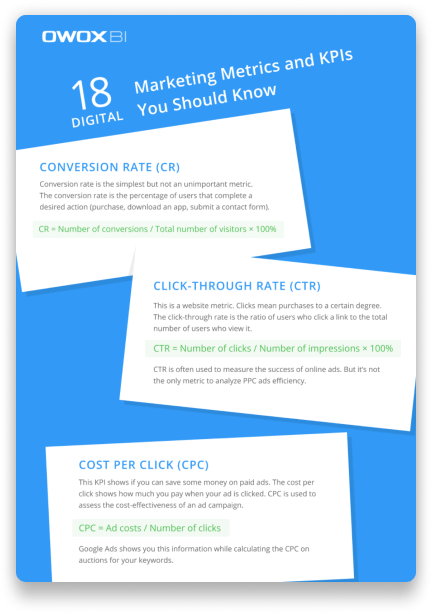
Interpreting KPIs in Marketing Reports
Interpreting KPIs involves evaluating the effectiveness of marketing campaigns against pre-established goals and KPIs. This step is vital for assessing campaign performance and guiding better decision-making.
Data Visualization and Presentation
Data Visualization and Presentation in marketing is about turning your data and numbers into easy-to-understand graphs and charts. This is important because it makes it easier for everyone in your company, from team members to top bosses, to understand what the data means. Good visualization highlights the key points and findings from your marketing data, making it clear where things are going well and where improvements are needed. This clarity is essential for making informed decisions and planning future marketing strategies.
Choosing the Right Graphs and Charts
The right graphs and charts are chosen based on the campaign's goals and objectives, ensuring they provide a concise and valuable overview for stakeholders. Marketing dashboards are particularly useful for this purpose.
Tips for Clear and Engaging Presentation
A clear and engaging presentation starts with a summary that provides holistic and actionable insights from key data points. The report should highlight primary marketing channels, the report's scope, and the results of marketing initiatives.
Marketing Analytics Reports and Examples
By analyzing Marketing Reports, businesses can gain insights into what marketing tactics are working, where they can improve, and how to better allocate their marketing budget. Each type of report focuses on different aspects of marketing and provides specific insights, from tracking sales trends to measuring the impact of social media campaigns.
Here are a few marketing report examples that provide practical illustrations of how data can be organized and presented to inform marketing decisions and strategies
Sales Performance Reports
Sales Performance Reports help businesses track and analyze their sales activities, both online and offline, revealing trends and areas for improvement. They provide insights into overall sales effectiveness and guide strategic decisions.
These reports typically include:
Overview of sales operations
Specific sales KPIs
Analysis over a set time period
Graphs and charts for data visualization
Executive summary for top management
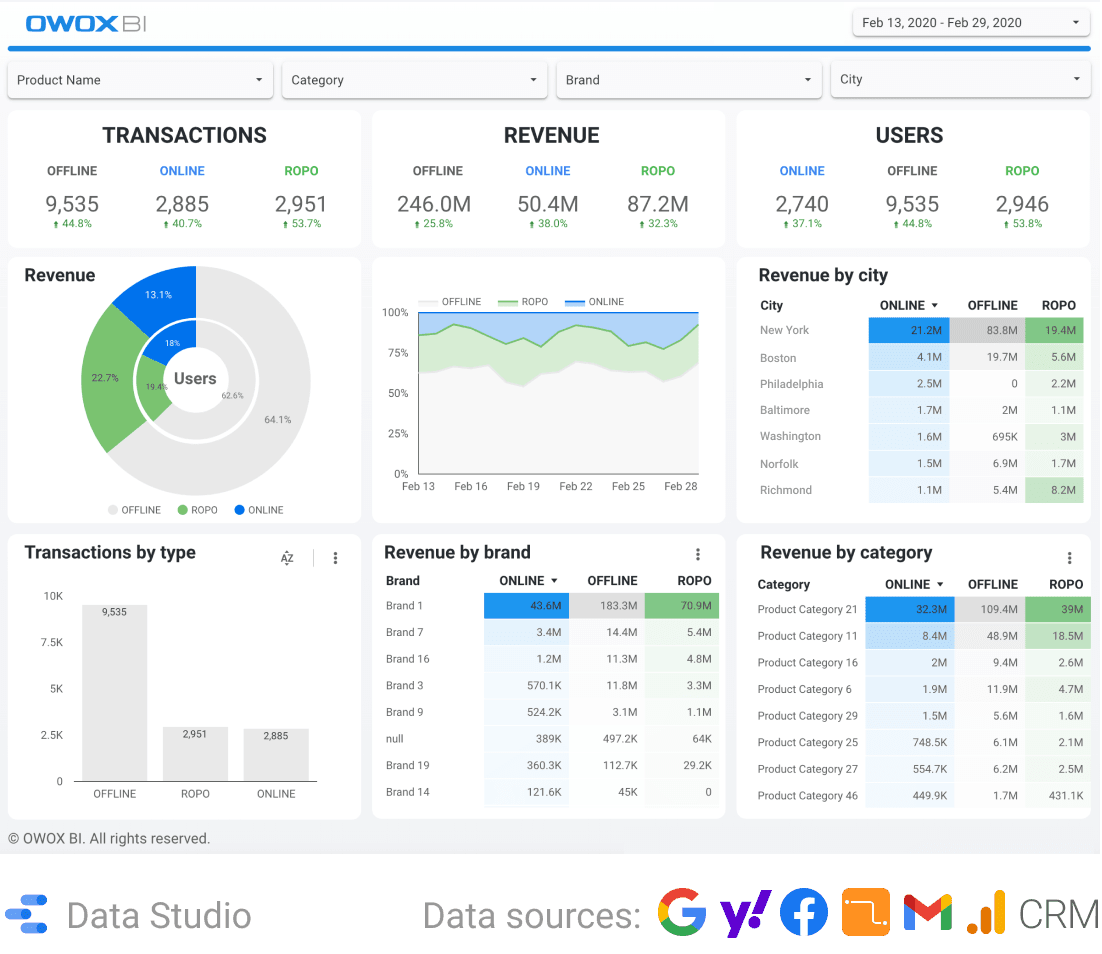
Analyze your online and offline sales data with Ropo Dashboard by OWOX BI. Combine offline and online sales data to get an omnichannel view of your business performance.
Social Media Metrics Reports
Social Media Metrics Reports track both paid and organic marketing efforts on platforms like Facebook, Twitter, Instagram, YouTube, and LinkedIn. These reports evaluate the impact and reach of social media campaigns, tracking engagement, follower growth, and content performance across various platforms.
Key elements of these reports include:
Target audience demographics
Likes and followers
Impressions and reach
Engagement rates
Top-performing posts
Hassle-free data analysis and reporting
Easily collect, prepare, and analyze marketing data. Stay on top of your marketing performance
4.9
Website Traffic and Conversion Reports
Website Traffic and Conversion Reports focus on how visitors interact with a website and their conversion into customers, essential for understanding and optimizing online user experience and effectiveness.
Key elements of these reports include:
Total website visits
Source of traffic (organic, referral, direct, etc.)
User behavior (pages visited, time spent, etc.)
Conversion rates
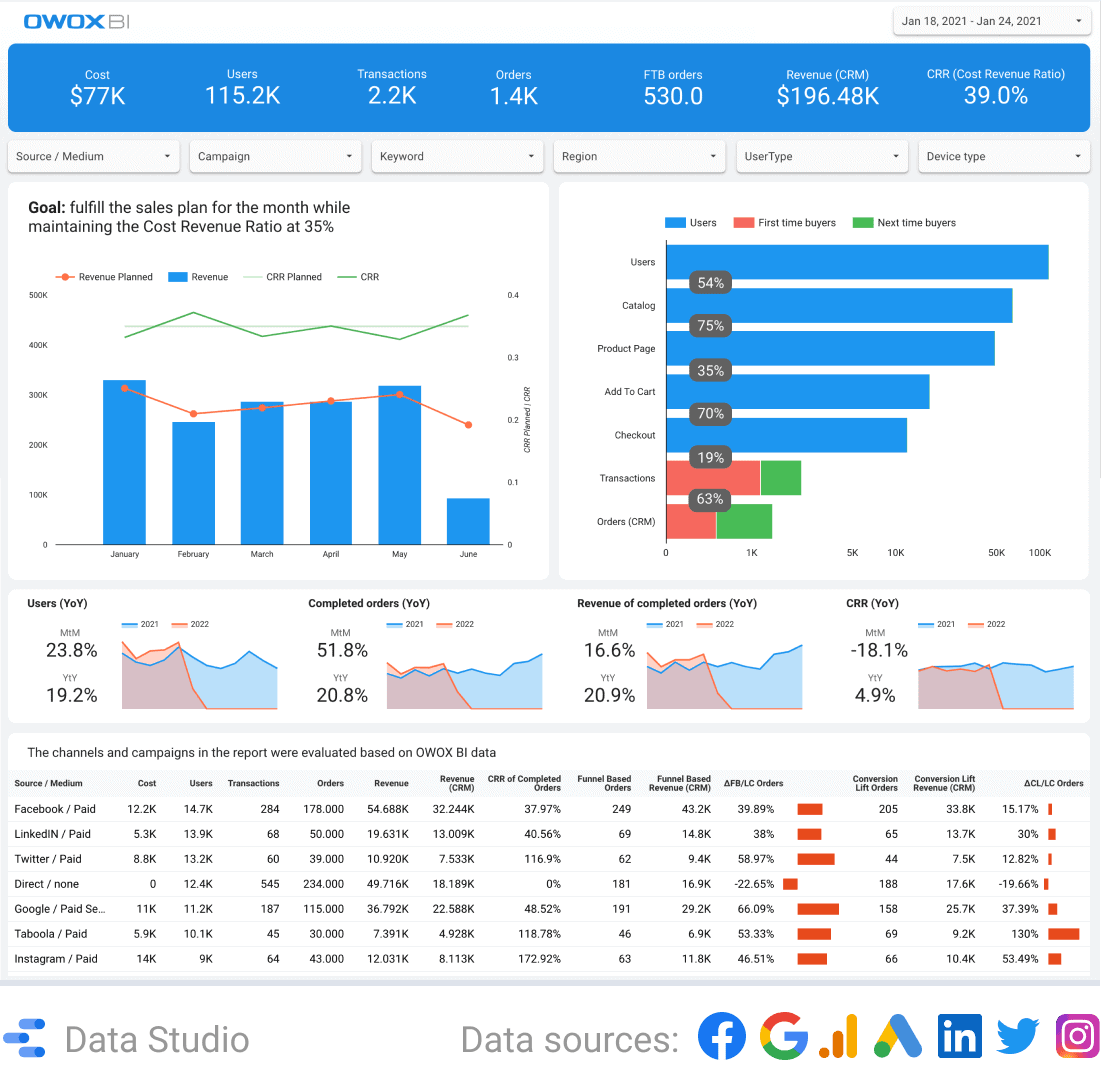
Here is our Digital Marketing Performance Dashboard Template that tracks all the important marketing KPIs at one place, You can download it here.
Email Marketing Reports
Email Marketing Reports analyze the performance of email campaigns, tracking open rates, click-through rates, and overall effectiveness in engaging recipients and driving conversions.
Email Marketing Reports should include:
Number of emails sent
Unique open rates
Click-through rates
Overall campaign performance
PPC Reports
PPC Reports provide insights into the performance of pay-per-click advertising campaigns, including metrics like leads, revenue, click costs, and conversion rates, crucial for optimizing ad spend.
They should include:
Number of leads generated
Revenues
Clicks and costs
Conversion rates
Ad performance by channel
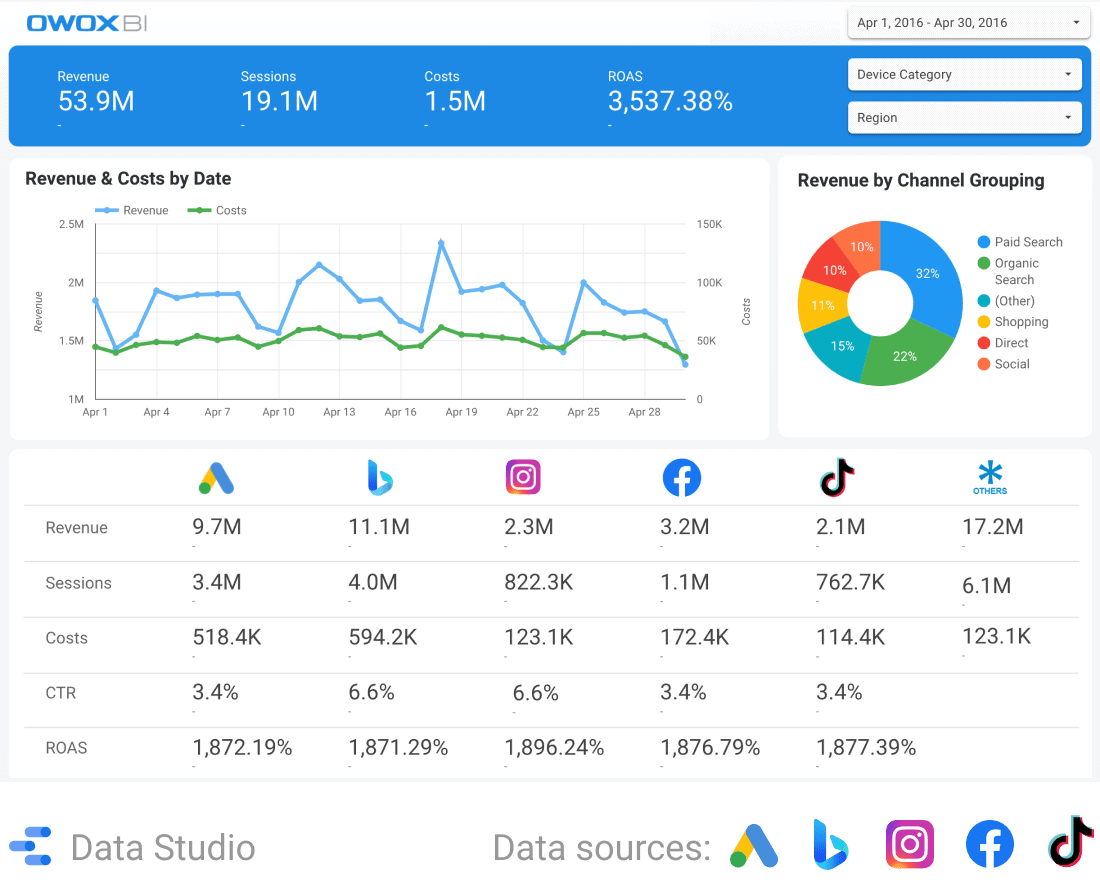
OWOX BI’s PPC Dashboard Template tracks all the important metrics for you, download the dashboard for free here.
Types of Marketing Reports and Templates
To avoid the well-known end-of-the-month syndrome, a burning keyboard, and convulsive attempts to collect data into a report, let’s figure out what types of marketing reporting there are. Most often, reports are compiled:
annually
monthly
weekly
daily
on demand
It’s worth noting that annual, monthly, weekly, and daily marketing evaluation reports are most often prepared in the form of dashboards, while on-demand reports are usually assembled using spreadsheets.
Different reports are required at different times, for different purposes, and for different people. Ideally, you should be prepared for everything in advance.
Note: Before you begin to create dashboards, be sure to determine the main metrics that are important for your business. After determining the metrics that are significant for you, start collecting and merging the data itself. However, be aware that it's about collecting all marketing data in a single convenient strucutre from the website, Excel documents, Google Sheets, ad services, Google Analytics, CRM and call-tracking systems. Get up-to-date and unified data ready for further segmentation and reporting with OWOX BI.
OWOX BI automatically collects raw data from different ad sources and converts it into a report-friendly format. You’ll get ready-made datasets that are automatically transformed into the proper structure, taking into account nuances important to marketers. No more spending time on data discrepancies and complex transformations. Just focus on data analysis.
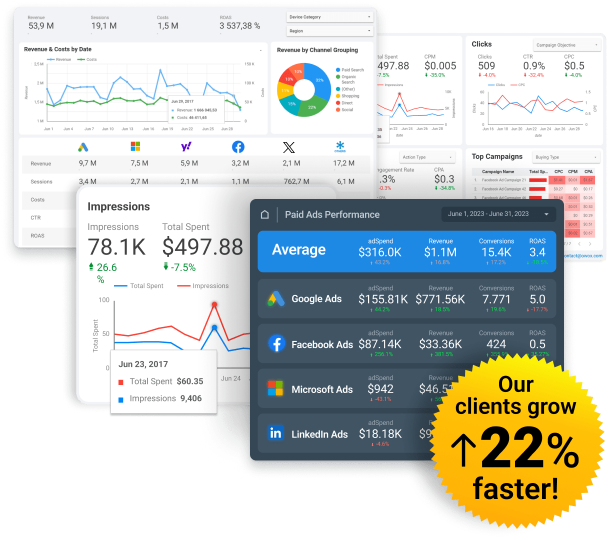
Gain clarity for better decisions without chaos
No switching between platforms. Get the reports you need to focus on campaign optimization
Annual marketing reporting
Annual reports such as marketing strategy dashboards are required by CMOs and CEOs. These reports focus on the overall performance of your department, your strategy, and your goals for the past year. In the screenshot below there's an example of the Performance report which is used to optimize the sales funnel and find the channels that perform best at a particular stage.

Such a dashboard helps to keep track on the fulfillment of the digital sales plan as it displays the KPIs of ad campaigns and compares them to the previous year's plan and results. That means, marketers can regularly monitor the dynamics of indicators and quickly make changes to ad campaigns to achieve their goals.
Moreover, with the help of this kind of report marketers can find bottlenecks in a funnel:
see how users go through it and at what stage they most often leave it.
how many online orders are eventually redeemed.
what the proportion of the first and repeat purchases is.
Monthly marketing reporting
Unlike annual reports (which are general) and weekly reports (which are detailed), monthly reports provide an overview of information for the period of a few weeks that’s required for marketing insights. Like, if in a weekly dashboard one channel brings the most leads, this doesn’t necessarily mean these leads will be of high quality (at least a couple of weeks need to pass before you can find out the actual results).
As an example, by using an E-commerce marketing performance report on a monthly basis, marketers can track their monthly marketing and sales plans to show effectiveness in terms of metrics that are of interest to their company (ROI, CRR, revenue, etc.).
How do users from different traffic sources behave?
How much does it cost to attract them?
What profit do they bring in?
A monthly dashboard answers these (and more) questions and helps to optimize the marketing budget.
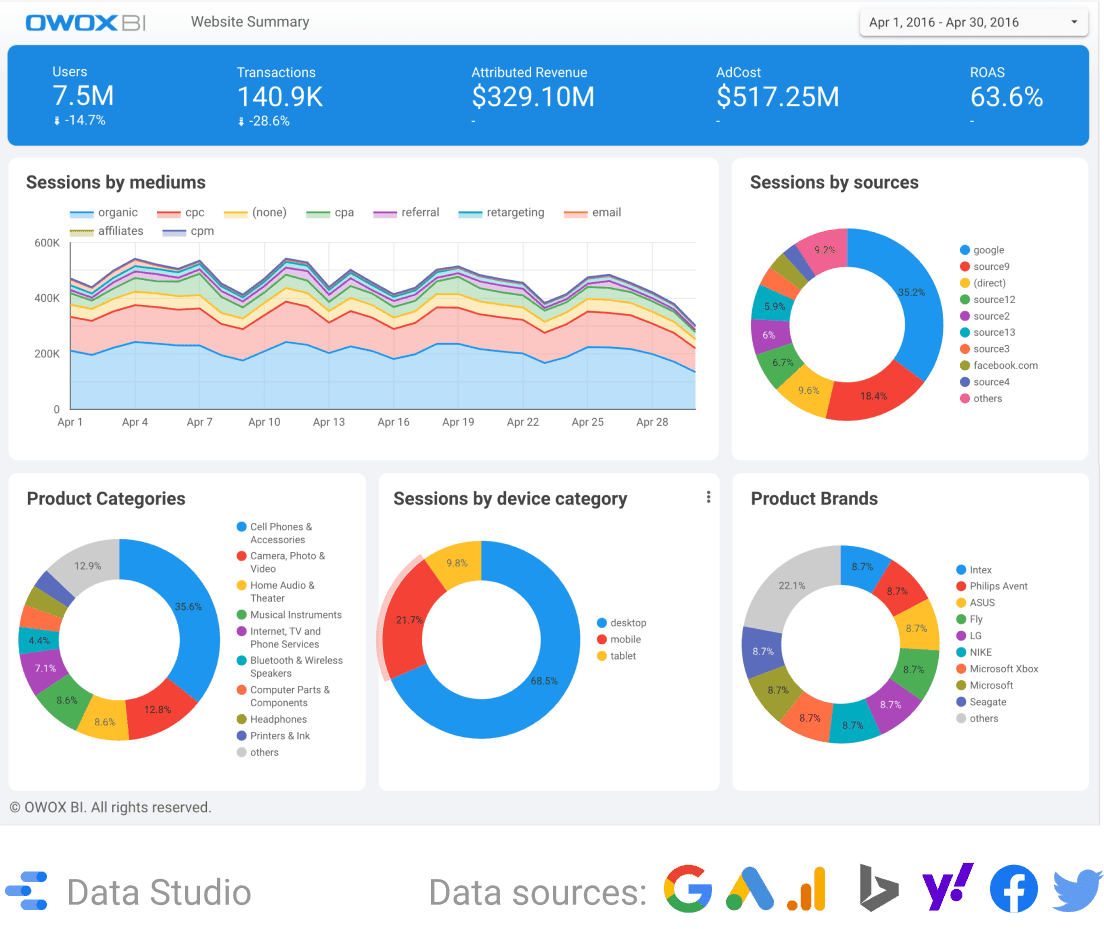
With the help of monthly dashboards, it's easy to analyze the effectiveness of ad campaigns since marketers can quickly find out what share of profits are generated by various brand and non-brand campaigns.
It's also possible to compare the conversion and ROI of advertising campaigns separately for Facebook or any other sources and analyze conversion data from organic traffic to assess the effectiveness of site optimization.
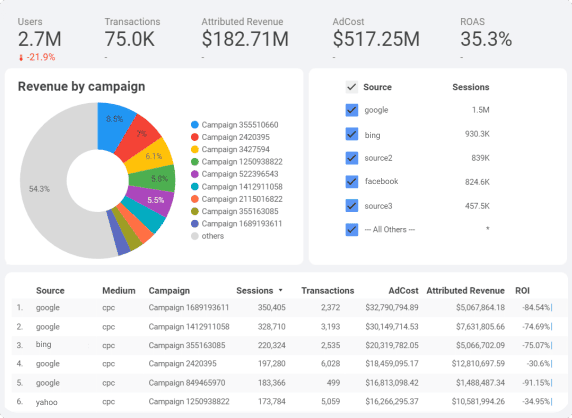
Weekly marketing reporting
Thanks to weekly traffic monitoring, you won’t miss any “trouble” that can affect the results of your department. Data collected over the course of a week helps you make decisions that affect monthly progress and form the basis for future decisions.
One example of weekly marketing reporting is evaluating the performance of paid traffic channels. By applying such a report, marketers are able to analyze statistics from Google Ads, Facebook, and other advertising sources on one dashboard.
Say no to switching between reports or manually summarizing data in Excel and Google Sheets, by having a report like this, it's possible to compare the effectiveness of advertising channels on a go.

By using weekly marketing reporting marketers can compare the efficiency of sources, the profits, costs, displays and clicks, CTR, and ROAS of all traffic sources and draw conclusions about their payback. Thanks to applying such a report, it becomes easy for marketers to find out which sources work best, where they need to invest, and where they shouldn’t waste their budget.
Daily marketing reporting
Daily marketing reporting helps marketers to make fast, data-informed decisions, allowing them to react in almost real time to any errors. With daily checking, it's also possible to track small experiments and notice problems (website errors, unavailable items, etc.) before they grow into global difficulties. In addition, daily tracking allows you to be confident in your numbers and know the current state of affairs.
Of course, the results of one day don’t affect the results of an entire advertising campaign. However, changes over several days in a row can show a trend. Although you shouldn’t get too attached to daily reports, it’s a good practice to check the most important metrics every day. For example, marketers can monitor the analysis of advertising campaigns based on item availability report and quickly see the proportion of visits from paid sources in which users land on out-of-stock goods.
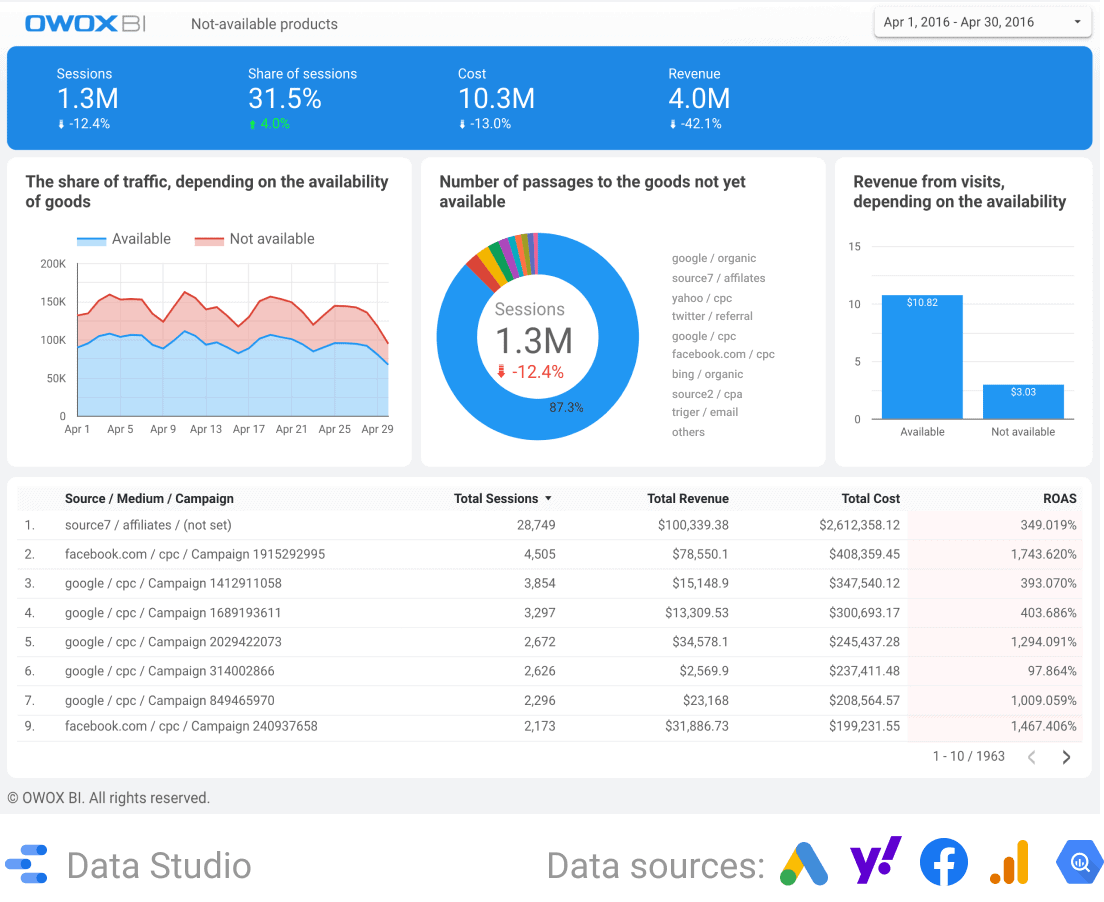
Analyzing traffic sources based on merchandise availability helps marketers to respond faster to the causes and reduce losses.
Otherwise, the situation could be like this: marketers spend money attracting an audience, but when a user gets to a product card, the item may not be available, meaning that all money spent on this ad campaign goes down the drain.
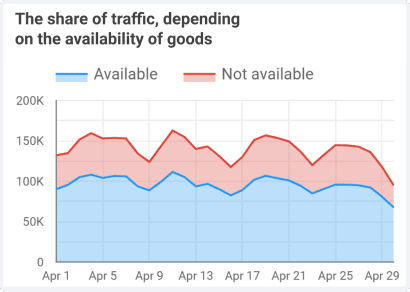
Why accurate marketing reporting is so crucial for business
Analytics and reporting are essential for any company regardless of size or industry. They help you assess how (and which of) your company’s efforts affect sales growth, total revenue, and the overall success of your brand on the market.
Marketing Reporting is crucial to help you tailor your marketing plans and enrich your strategies by repeating your successes, identifying growth opportunities, and avoiding things that have proven ineffective.
Though data is everywhere, it’s not always easy to present it in an understandable format. Your marketing campaigns may have excellent results, but if you cannot present those results and prove the success of your campaigns, then your marketing efforts will not be of much use. The more accurate your measurements, the higher (and more apparent) the marketing value will be for your company. Accurate analytics is key to business success. You can’t prove your importance, necessity, and value if you don't measure your work. Measuring your work helps you:
Show the effectiveness of your marketing investments.
Optimize your budget.
Help you make informed, data-based, strategic decisions.
Forecast results.
The digital marketing landscape is shaken by:
Accelerated digital business transformation. Digital transformation is happening so fast that there’s not enough time to adapt. As a result, you can quickly become an outsider.
Changes in the rules for collecting third-party data. Soon, how you can use third-party data will change significantly, and existing approaches will cease to work.
A completely new version of Google Analytics. A new data structure and a new approach to analytics mean Google Analytics 4 will break all existing day-to-day customized reports.
The current situation resembles riding out a storm; you don’t have time to overcome one wave before the crest of another appears.
As the amount of data marketers use steadily grows, business management wants clear answers to questions: What efforts worked out? Where should we invest to earn more? Answering these questions is impossible without advanced reporting. Marketing analytics is no longer just a theory or a toy for big rich companies. It has become both more accurate and more urgent. With its help, marketers can defend their budgets, control spending, evaluate marketing efficiency, and, most importantly, use data to improve marketing and meet goals.
The pandemic has boosted online media usage. As Gartner research from 2020 shows, digital channels accounted for almost 80% of marketing budgets, with digital advertising representing 22% of total spending. Moreover, the customer’s path to conversion is becoming more fragmented as customers useare using more devices to search for brand information.
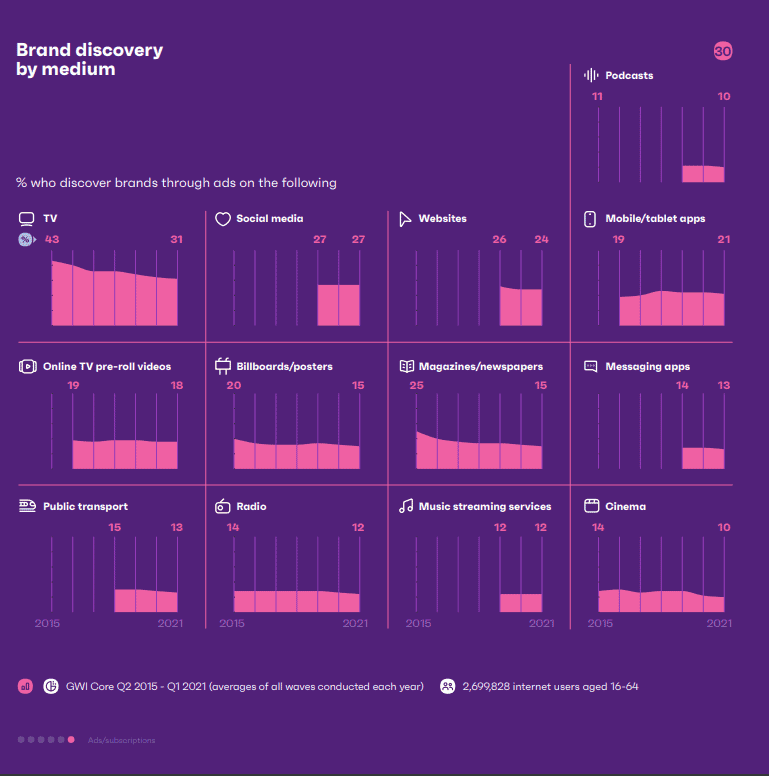
However, to efficiently use a massive amount of data from these channels, you need to spend a lot of time and resources on creating an analytics system (data storage, connectors, visualization of a large number of different reports for different requests), which is a long, painful, and difficult process.
Data collection alone (which involves handling different data structures and formats and sorting out duplicate or irrelevant data) can take the lion’s share of your time. But you still need to put that data to work! A marketer still needs the help of an analyst to create a report, which can take five days on average. And all this time, the marketer cannot act based on data insights but only on intuition. However, modern all-in-one cloud solutions like OWOX BI make marketers’ lives easier.
How to Improve your Marketing Reporting
With an accelerated transition to online marketing (thanks to the pandemic) and an increase in marketing budgets for digital promotion, marketers increasingly have to prove their value.
There’s a vast amount of marketing data from various sources that you can use to get many valuable insights. However, analysts are often busy, and most marketers don’t know how to build reports on raw data by themselves.
Let’s see why it’s so crucial for marketers to be able to create various reports using a large number of data sources — and to do it on their own.
Why marketers need to be able to build their own reports
It's increasingly difficult for marketers to work efficiently, as more and more is being demanded of them. Technologies are developing quickly, and many changes are happening (new Google Analytics 4, third-party data restrictions, etc.); it’s simply impossible to follow them all with advertising becoming more expensive and increasing competition.
The magic that can help marketers fulfill their goals and prove their value in the market is called analytics: with right data, you can get everything you need. According to Gartner, 85% of marketers say that by 2022, “significantly more” of their organization’s marketing decisions will be based on marketing analytics. However, only 54% of marketing decisions are currently made with the help of analytics.
Why don’t marketers rely on marketing analytics to make decisions:
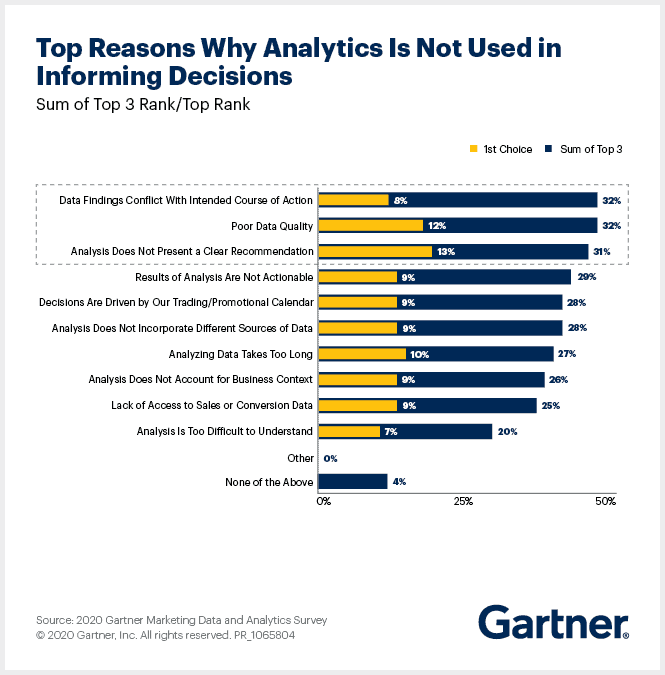
Among the main pains that marketers face are:
Poor data quality (duplicated, missed, and inaccurate data)
Finding relevant insights (not actionable and unclear recommendations)
Creating ad hoc reports (too difficult to do without technical knowledge)
Let’s figure out why these challenges prevent marketers from working effectively.
There’s a massive amount of fragmented marketing data coming in (data with different structures and formats) and limited time and resources to process it. And keep in mind that if you don’t collect all data or you collect the wrong data, you will take action based on faulty information (marketers waste 21% of their marketing budgets because of bad data).
To be sure of the data you collect, you have to update it, check its quality, and make sure the connector you use supports updating the APIs of the services you use to collect data. Also, it’s, by all means, necessary to get raw unsampled data, avoid duplication and data loss, avoid distorted reporting, and ensure the relevance and high granularity of data collected. Another problem is that it’s very difficult to blend data correctly to build reports (keeping in mind that marketers cannot say in advance what reports they will need).
After collecting data, marketers must decide which reports they need in the current situation. To control the marketing machine, you need two reports: performance reports and ad hoc reports.
The current approach to working with data isn’t optimal for marketers — they most often cannot build reports independently because it’s too complicated. To get answers to questions, they have to set tasks for analysts and wait for reports (at least three iterations per new dashboard). Why is this so? Until you get an answer to the first question, you don’t know what the second one should be.
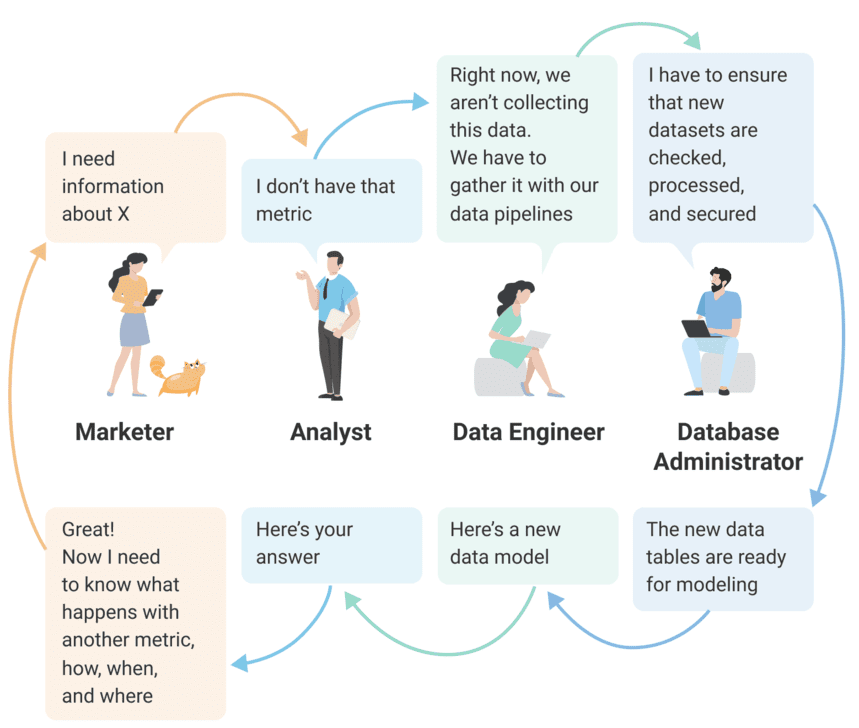
According to a study, the existing approach isn’t just long and unpleasant: the average time to create a report is 4.5 days, and the average cost of a report is $18,000.
The situation is complicated because marketers need to manipulate data and build many ad hoc reports to get the right insights to truly benefit from data. In addition, the results of calculations must be visualized and presented correctly.
And, as if this weren’t enough, analysts create different datasets for different reports. Over time, the more reports are built, the more complicated the entire system becomes. It’s like playing Jenga; if you pull out the wrong brick (delete or change one data table), everything will collapse in the end.
No one is immune to reporting problems — not even companies with well-tuned analytics, where all possible reports for any taste have long been ready to go. If the data structure changes (welcome Google Analytics 4), all SQL queries must be rewritten.
Fortunately, there’s still a way out of this nightmare. Marketers need to work with data on their own to increase revenues, perform more efficiently, and derive meaningful business benefits. Marketers should be able to build reports on their own using raw data that can be trusted, is complete, and is updated so it contains no errors. This means you don’t have to wait weeks for an analyst to build a report for you. Instead, you can choose the metrics you need right now and get a report in a few minutes.
If marketers can build their own reports, analysts can be engaged in more valuable work, marketers can be their own masters, and the company can grow its profits. Want to know how to make this fairy tale a reality? Sign up for a demo with our experts to see how OWOX can help your business right now!
How to build a perfect marketing report
Building reports that are slightly different from standard templates is not easy for marketers. Mainly, existing analytical products are aimed at the needs of analysts and developers and prohibit marketers from working with data themselves.
Marketers are still forced to limit themselves to ready-made reports or wait for analysts to prepare data, leading to missed opportunities and wasted time.
For example, you can get an automatically updated report in Power BI, Google Data Studio, or Excel. But you cannot do this yourself if you need to change something in the report — add sections, parameters, or metrics, or perhaps change the channel grouping. You have to ask an analyst every time.
Who’s gonna save your day? Modern marketing reporting tools! For example, OWOX BI — is one of the easiest and most convenient services to work with (according to G2 Crowd reports).
With OWOX BI you only need an analyst’s help initially while creating a customer data model. However, once your marketing data reflects your company’s business model, marketers don’t need to run to analysts whenever they want to create a new report. Once your data is modeled, marketers can build various reports on their own.
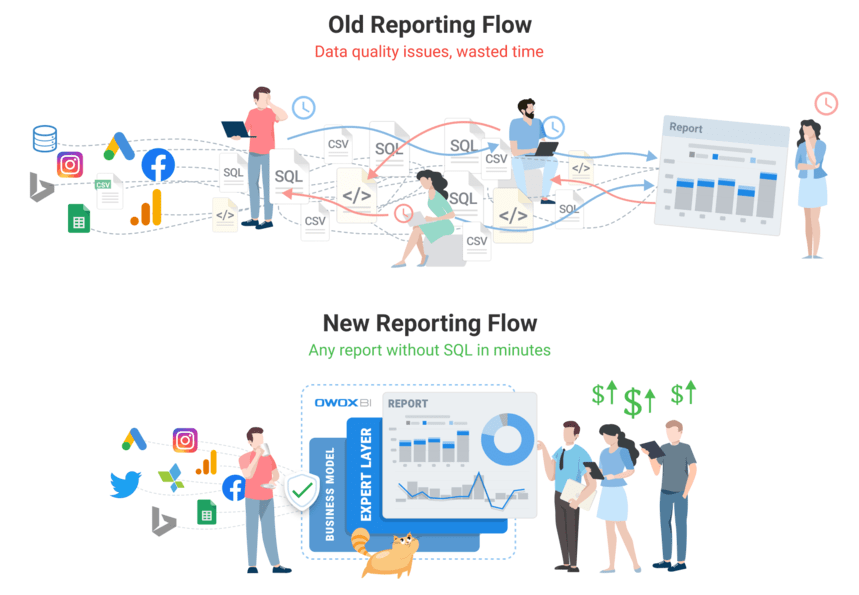
More importantly, even if the data structure changes (e.g., with Google Analytics 4), you won’t need to rewrite SQL queries, since with OWOX BI, such changes won’t affect you. The product will take the necessary steps, save you from a boring routine, and free up your time to focus on decisions to improve your marketing.
Let’s look at three simple steps you need to take to improve your reporting.
Start using Google BigQuery as your cloud data storage. It’s the best option on the market that considers marketers' needs.
Collect raw data from your website, ad platforms, and CRM in BigQuery.
Build report from a template with OWOX BI.
Webinar. How To Use Analytics To Boost Your Marketing Effectiveness
Learn how to build full-funnel analytics, evaluate marketing efforts, and discover the data-driven strategies to maximize ROI. Register now.
Watch the replay
Marketing Ninja @ OWOX
Other marketing reports templates for marketers to use
If you want to get all the mentioned above dashboards and get more reports of various complexities, visit the OWOX BI dashboard gallery. There are lots of different and complex templates for marketing reporting that you can receive in a few clicks. Get reports of any depth, compare the effectiveness of marketing channels, and make timely decisions with OWOX BI.
E-commerce dashboard. Item position effectiveness report
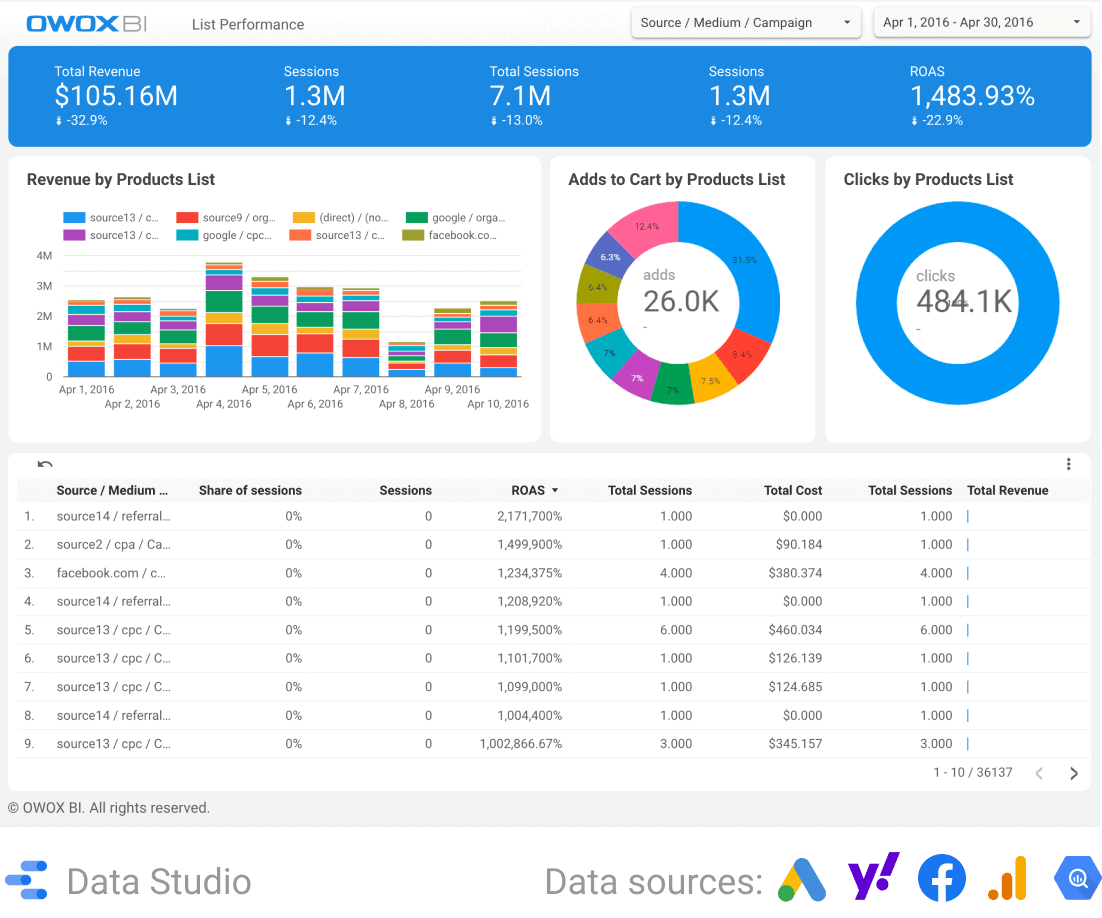
Learn how to properly position items on the website to increase conversions and the average check size.
Facebook advertising dashboard template
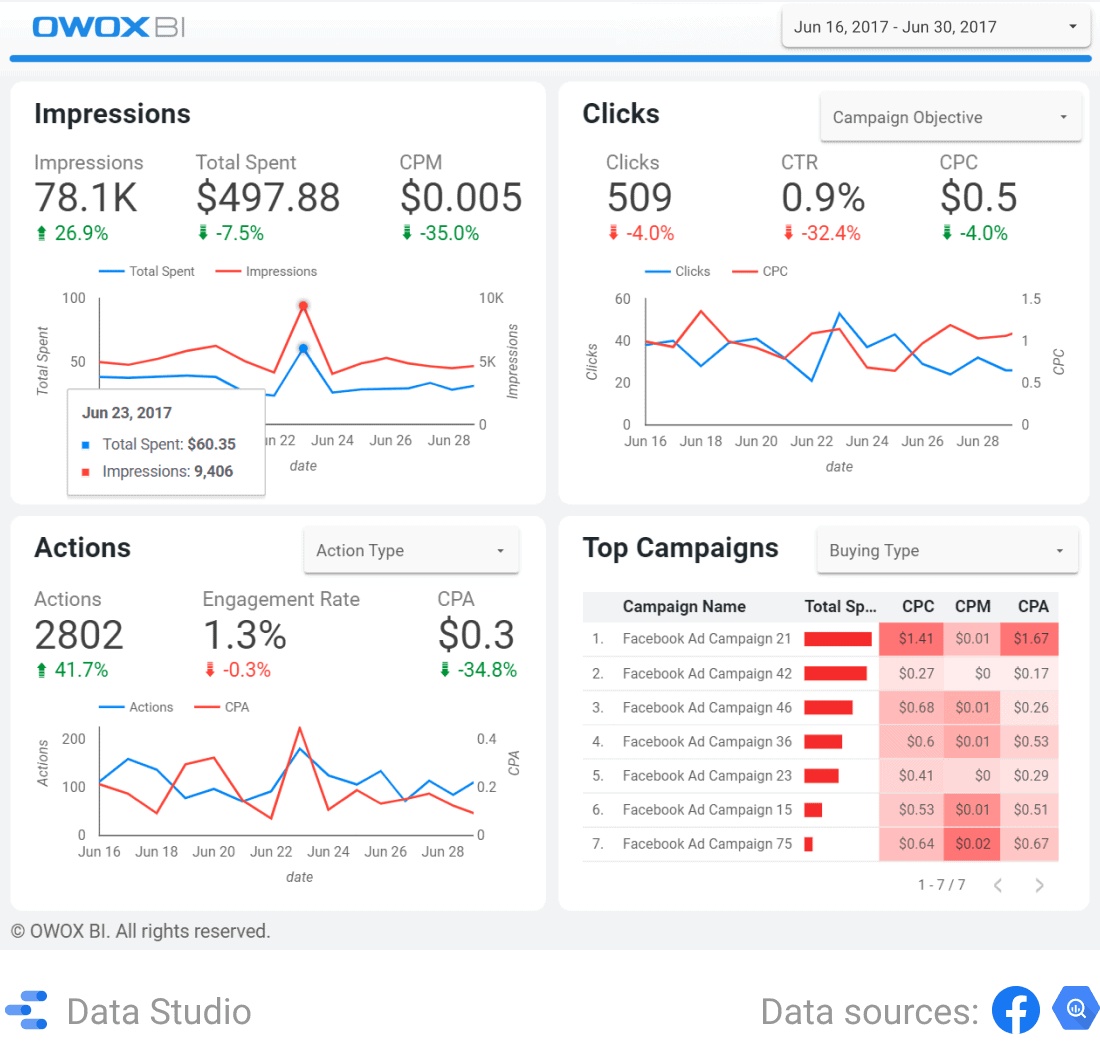
Analyze the core KPIs of your Facebook campaigns on one dashboard. Find the most effective campaigns and smartly allocate your budget.
Microconversion report
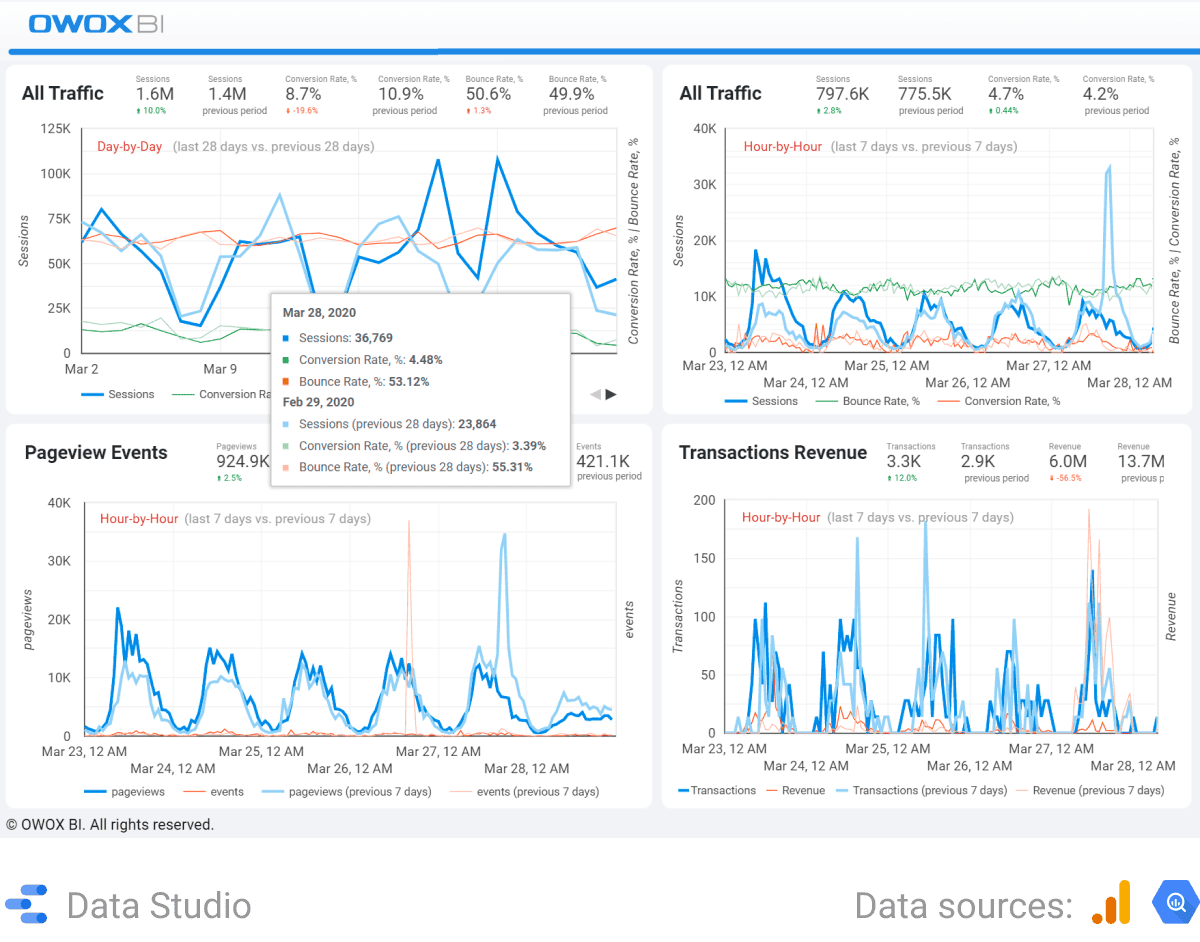
This OWOX BI dashboard will be useful for both marketers and development teams. It allows you to quickly detect and fix website conversion problems.
Digital marketing dashboard
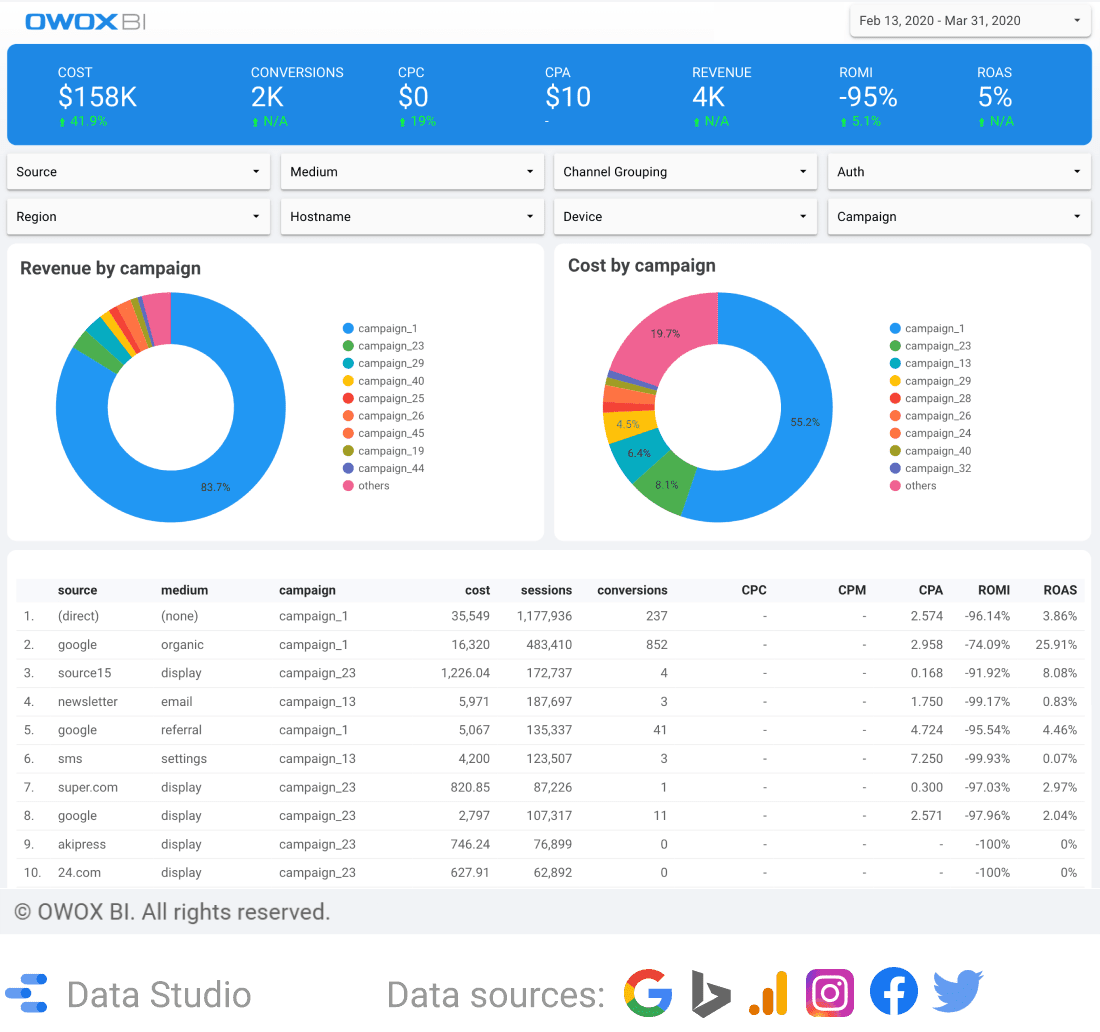
Analyze campaigns from Google Ads, Facebook, and other advertising services on one dashboard. Compare campaign performance and optimize your marketing budget.
Landing page effectiveness report
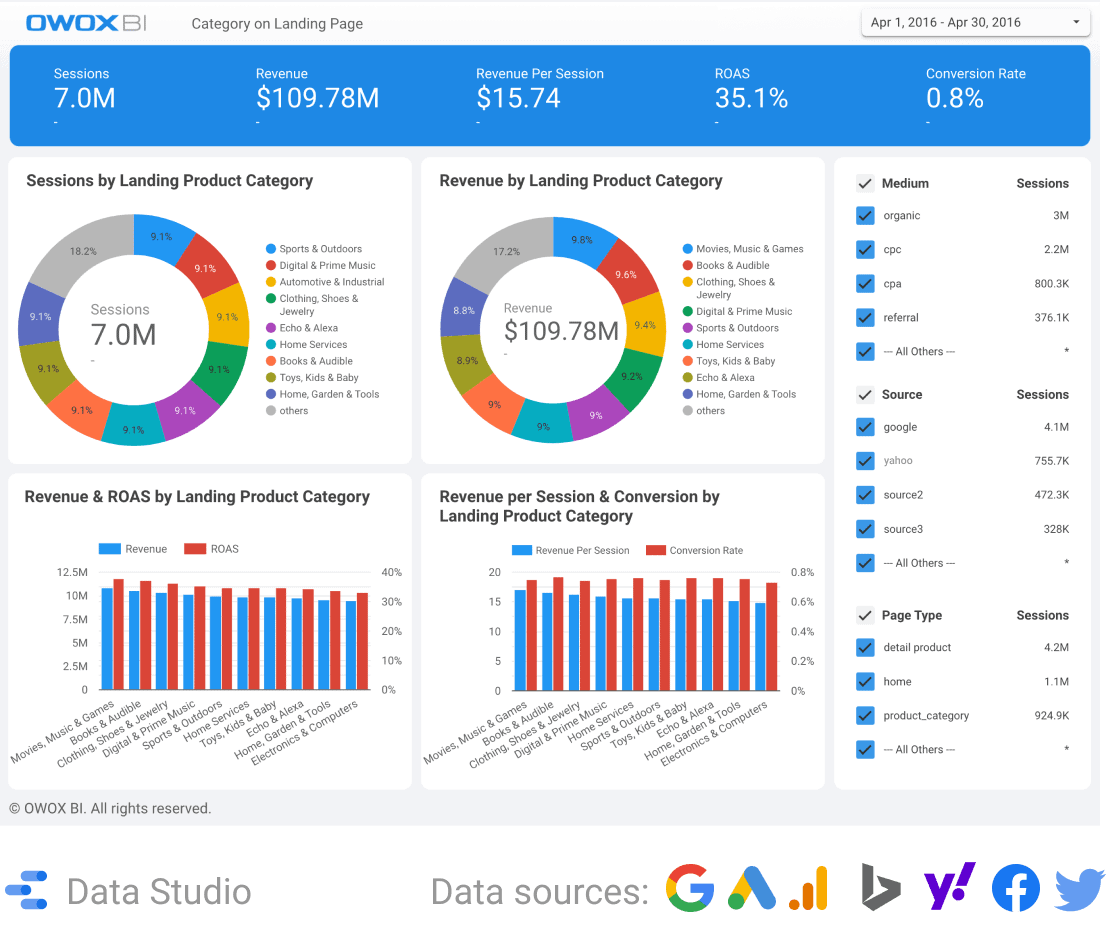
Find out which items and categories are more profitable to promote and which landing pages best convert visitors to buyers. Evaluate the effectiveness of advertising channels for various categories and landing pages to efficiently plan your budget and increase sales.
Best Practices for Interpreting Marketing Reports
When interpreting marketing reports, it's vital to adopt best practices that enable a deeper understanding of the data and its implications for business strategy. These practices ensure that the wealth of information available in marketing reports is translated into actionable insights, guiding informed decision-making and strategic planning.
Identifying Trends and Patterns
To effectively interpret marketing reports, it's essential to identify trends and patterns in the data. This involves looking for consistent occurrences or changes over time, such as increases in website traffic following specific campaigns or seasonal variations in sales. Recognizing these patterns can help predict future market behavior and inform strategic planning.
Making Data-Driven Decisions
To effectively interpret marketing reports, it's essential to identify trends and patterns in the data. This involves looking for consistent occurrences or changes over time, such as increases in website traffic following specific campaigns or seasonal variations in sales. Recognizing these patterns can help predict future market behavior and inform strategic planning.
Communicating Insights Effectively
To effectively interpret marketing reports, it's essential to identify trends and patterns in the data. This involves looking for consistent occurrences or changes over time, such as increases in website traffic following specific campaigns or seasonal variations in sales. Recognizing these patterns can help predict future market behavior and inform strategic planning.
Hassle-free data analysis and reporting
Easily collect, prepare, and analyze marketing data. Stay on top of your marketing performance
4.9
Key takeaways
With fewer resources, specialists are expected to show better performance. This is a real challenge! So what can marketers do to bolster their confidence in decision-making and get a holistic view of marketing performance?
- Start using modern BI tools like OWOX BI to survive the end of the third-party data era.
- Make your company data-driven.
- Use cloud-based solutions that make it easier to unlock the treasures in your marketing data and transform information into powerful insights and ad hoc reports that can boost your performance.
- Create the reports you need as often as you need and in the quantity you need without regular help from an analyst.
- Apply templates of dashboards to your regular marketing reporting. With handy templates like those we've mentioned above, it's easy to get a holistic view of marketing performance. And, what's most important, applying such templates can save your time and resources, meaning marketers will have more time to actually analyze the obtained data and get useful insights.
FAQ
-
What are marketing reports?
Marketing reports are documents that present data and insights related to marketing activities. These reports help businesses measure their marketing performance, identify areas for improvement, and make informed decisions. -
What types of marketing reports are there?
Some common types of marketing reports include social media reports, email marketing reports, website analytics reports, and SEO reports. Each report focuses on a specific area of marketing and provides insights related to performance and effectiveness. -
Why are marketing reports important?
Marketing reports provide valuable insights into the effectiveness of marketing campaigns and help businesses make data-driven decisions to improve their marketing strategies. These reports enable businesses to track progress over time and make adjustments to campaigns as required. -
How do I identify key trends in marketing reports?
To identify key trends, examine changes and patterns in the data over time, focusing on metrics like sales figures, website traffic, or social media engagement. -
What are the best practices for making data-driven decisions from marketing reports?
Best practices include thoroughly analyzing the data to understand its implications and basing strategic decisions on these insights rather than assumptions. -
How can I effectively communicate insights from marketing reports to stakeholders?
Use clear, concise language and visual aids like charts and graphs to translate complex data into understandable and actionable information for stakeholders. -
What should I do if the data in the marketing report is overwhelming?
Focus on the most critical metrics related to your goals and seek patterns or outliers in these areas to guide your analysis and decision-making. -
How often should I review marketing reports for my business?
The frequency depends on your business needs but typically ranges from weekly to monthly, allowing for timely adjustments to marketing strategies. -
Can marketing reports help in predicting future trends?
By analyzing past and current data, marketing reports can provide insights into future trends, helping in proactive strategy planning.












